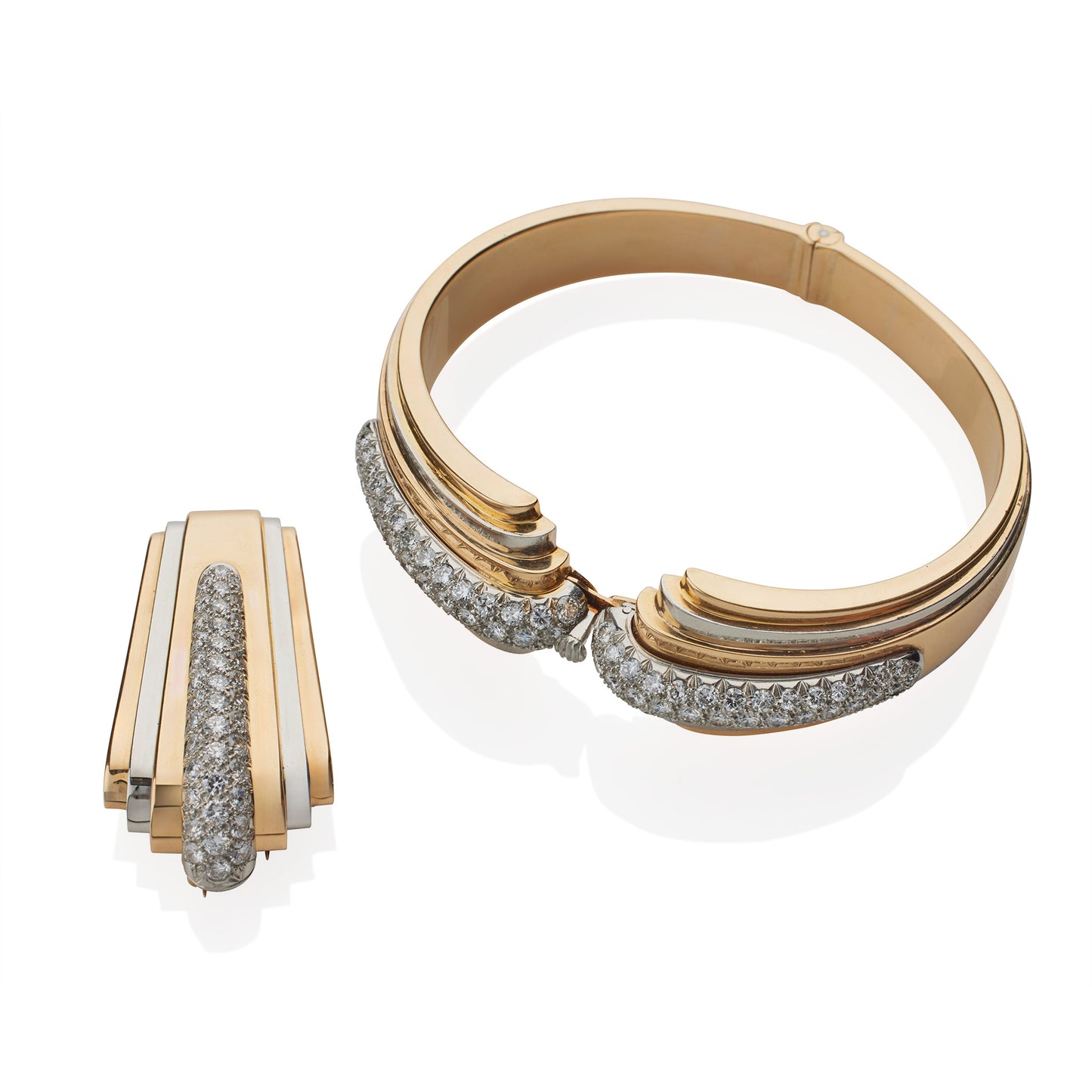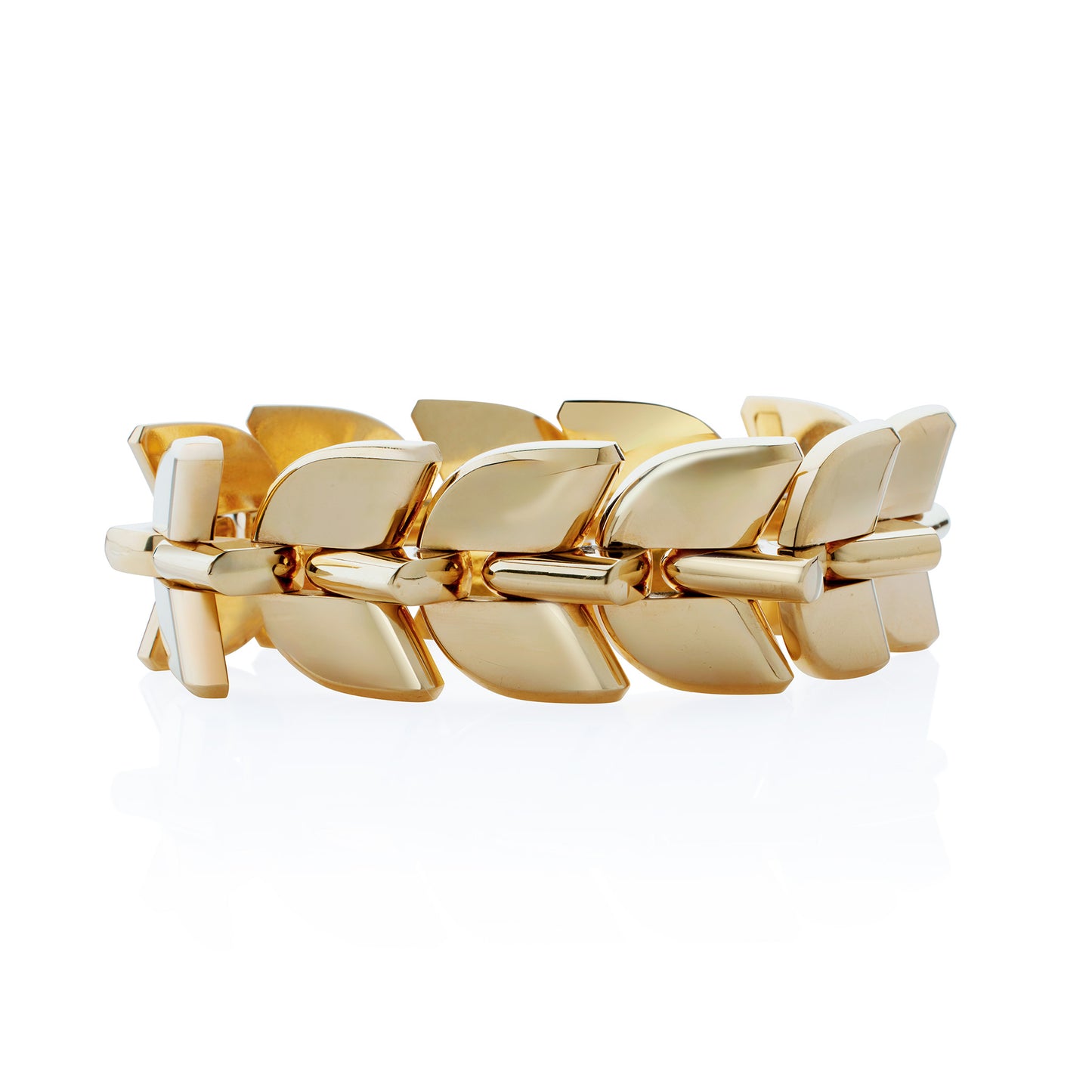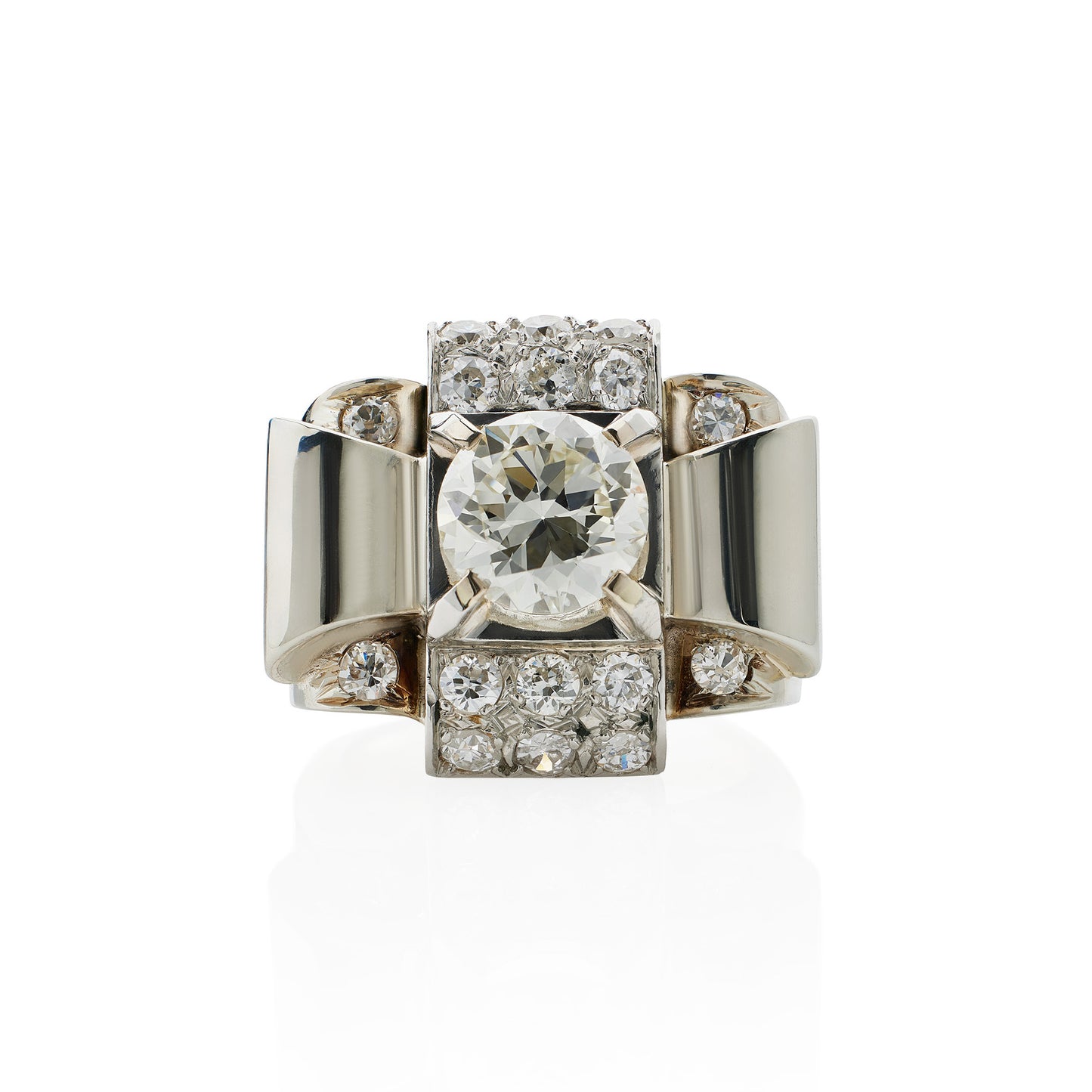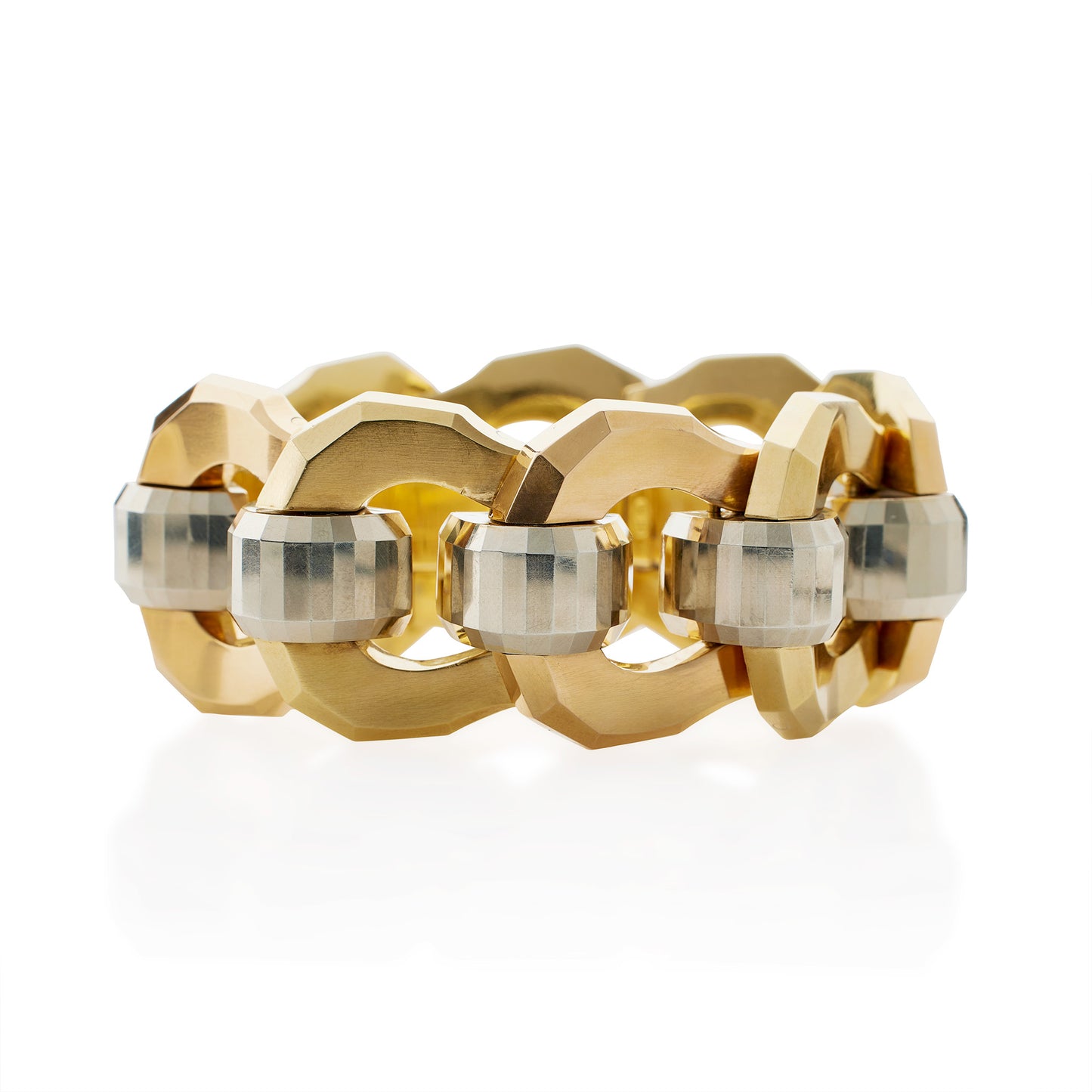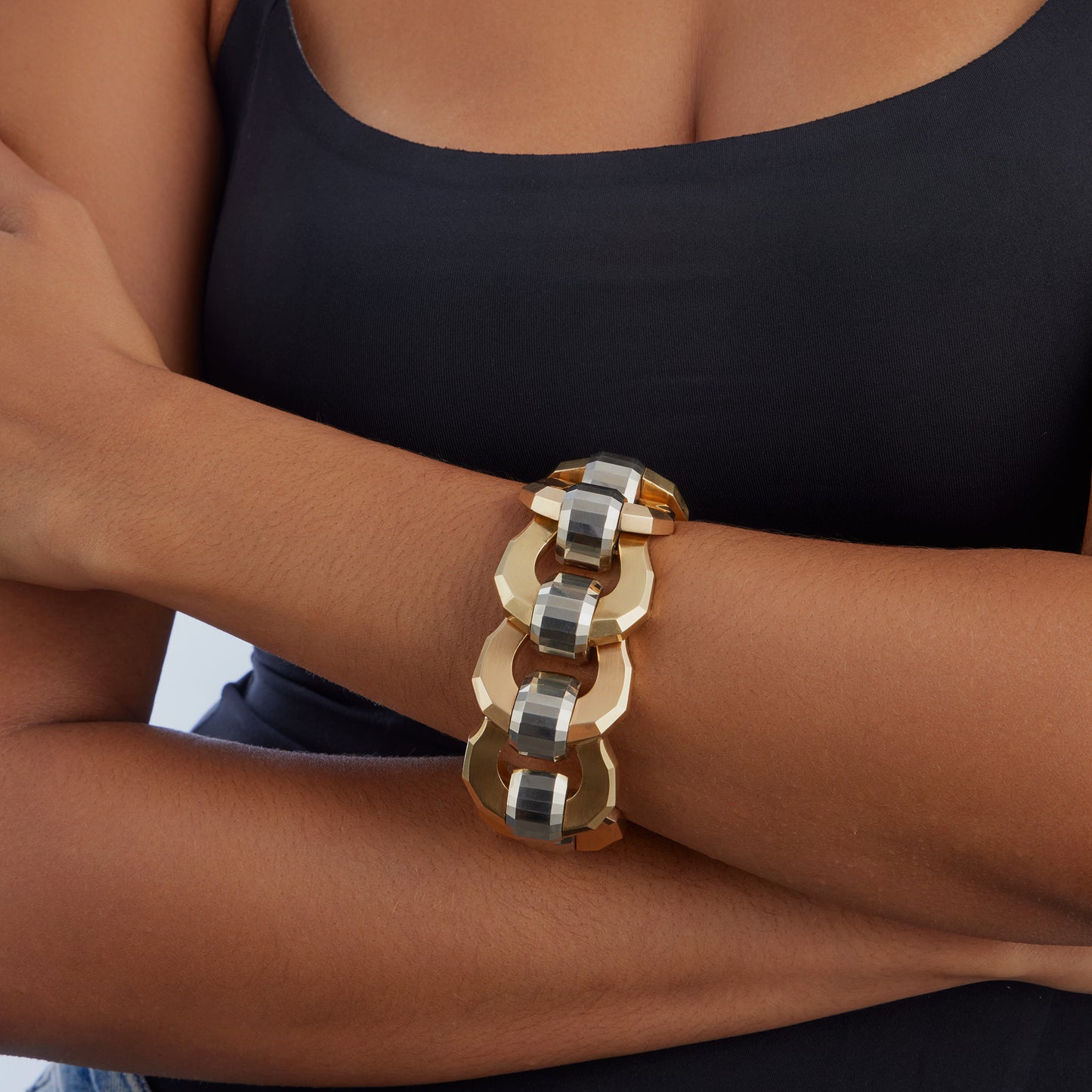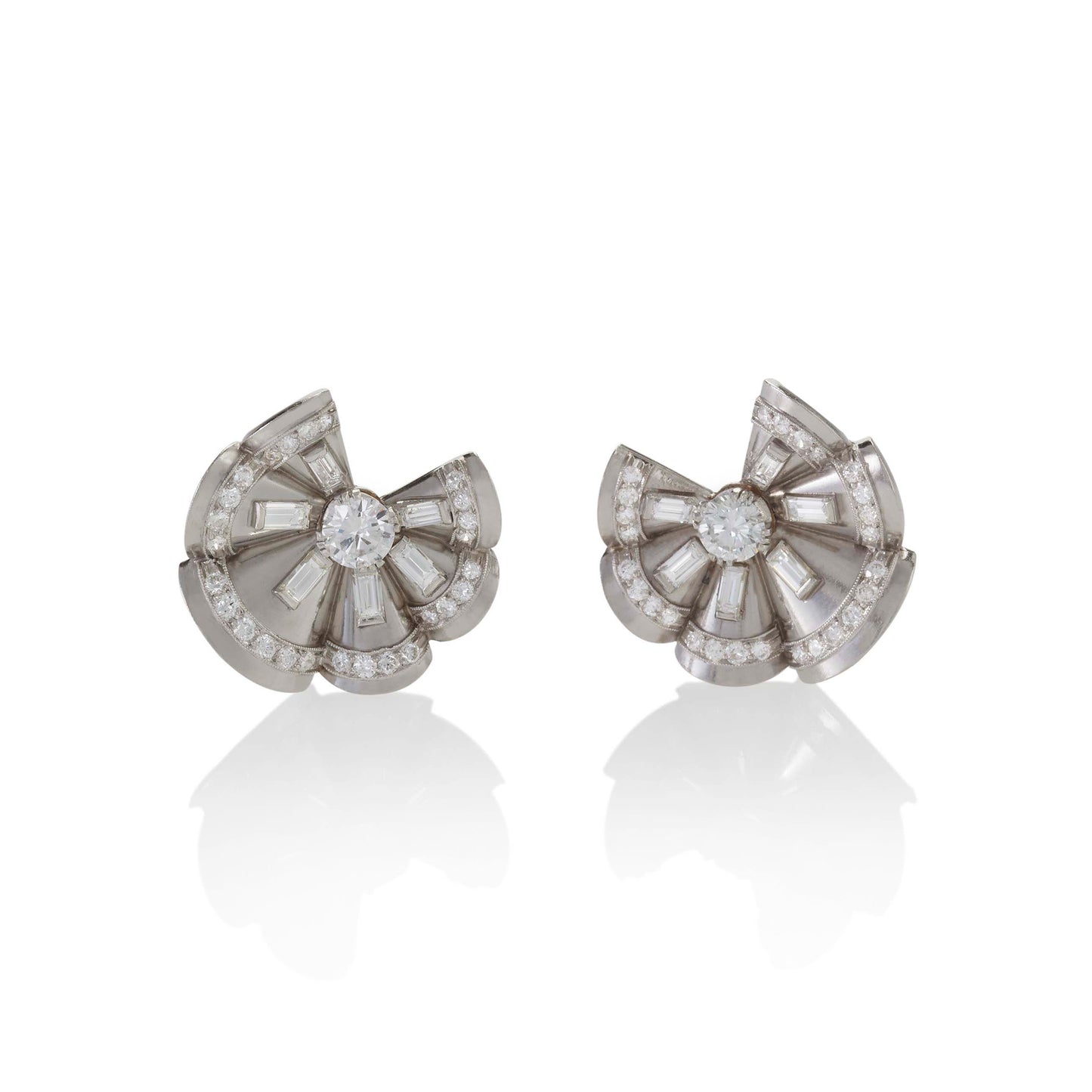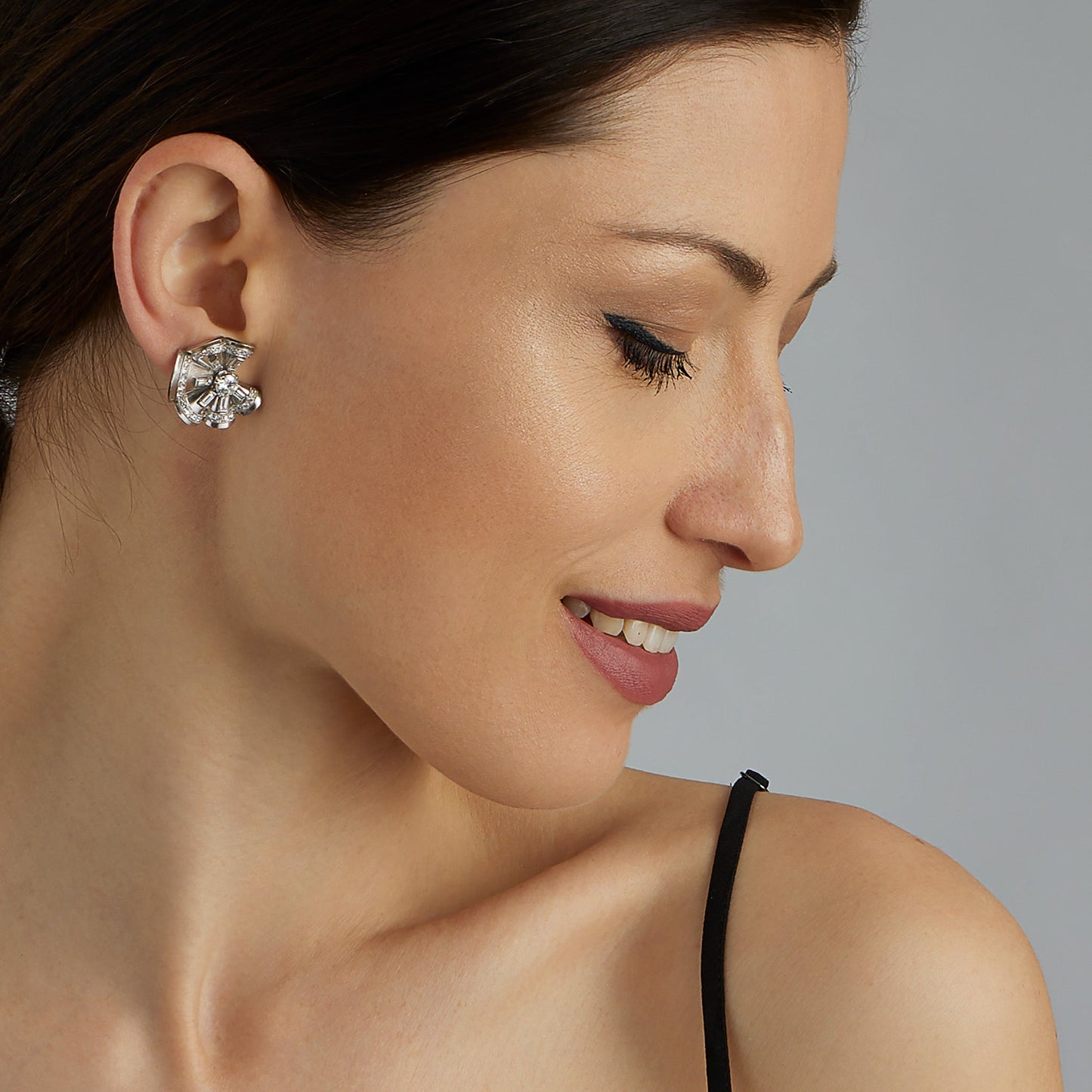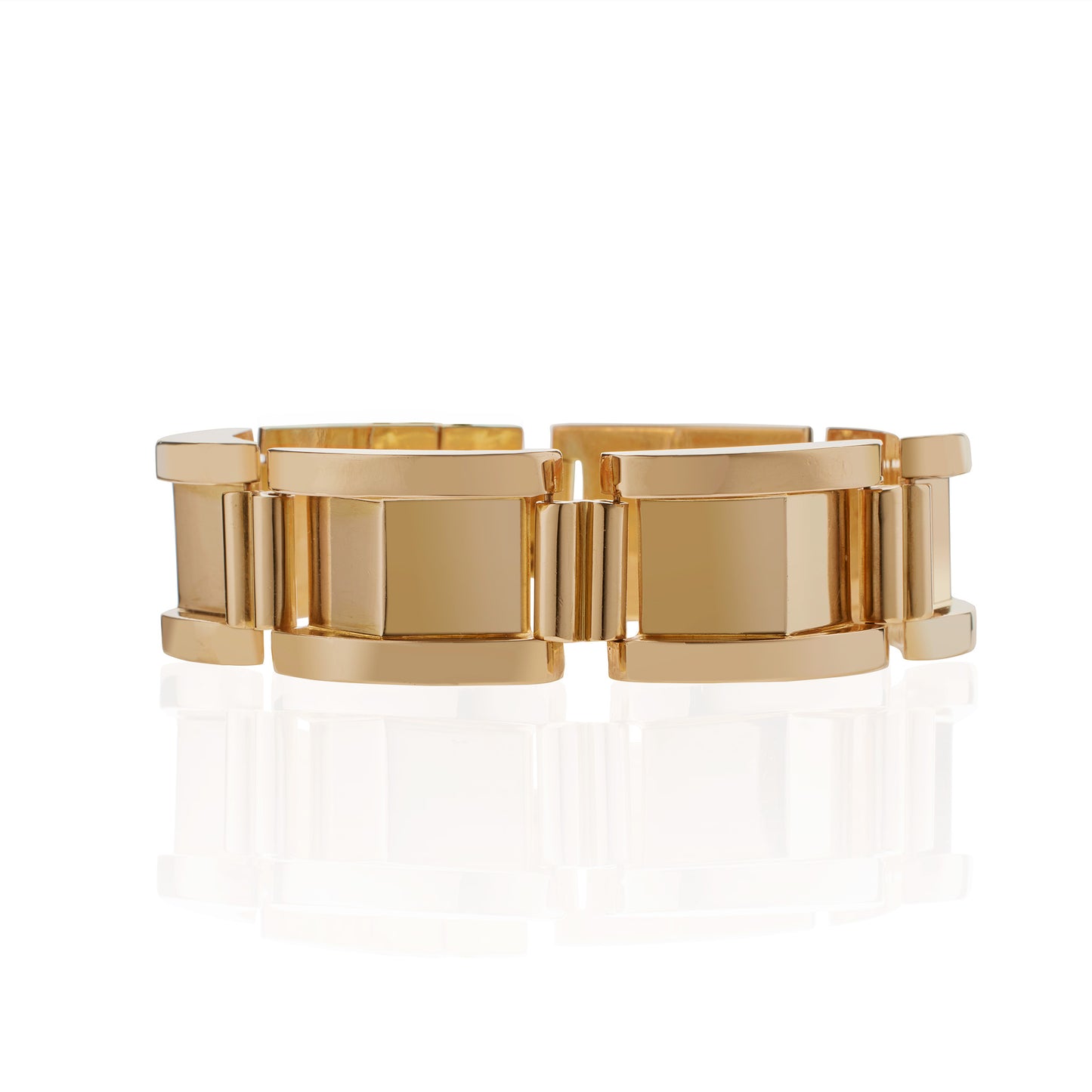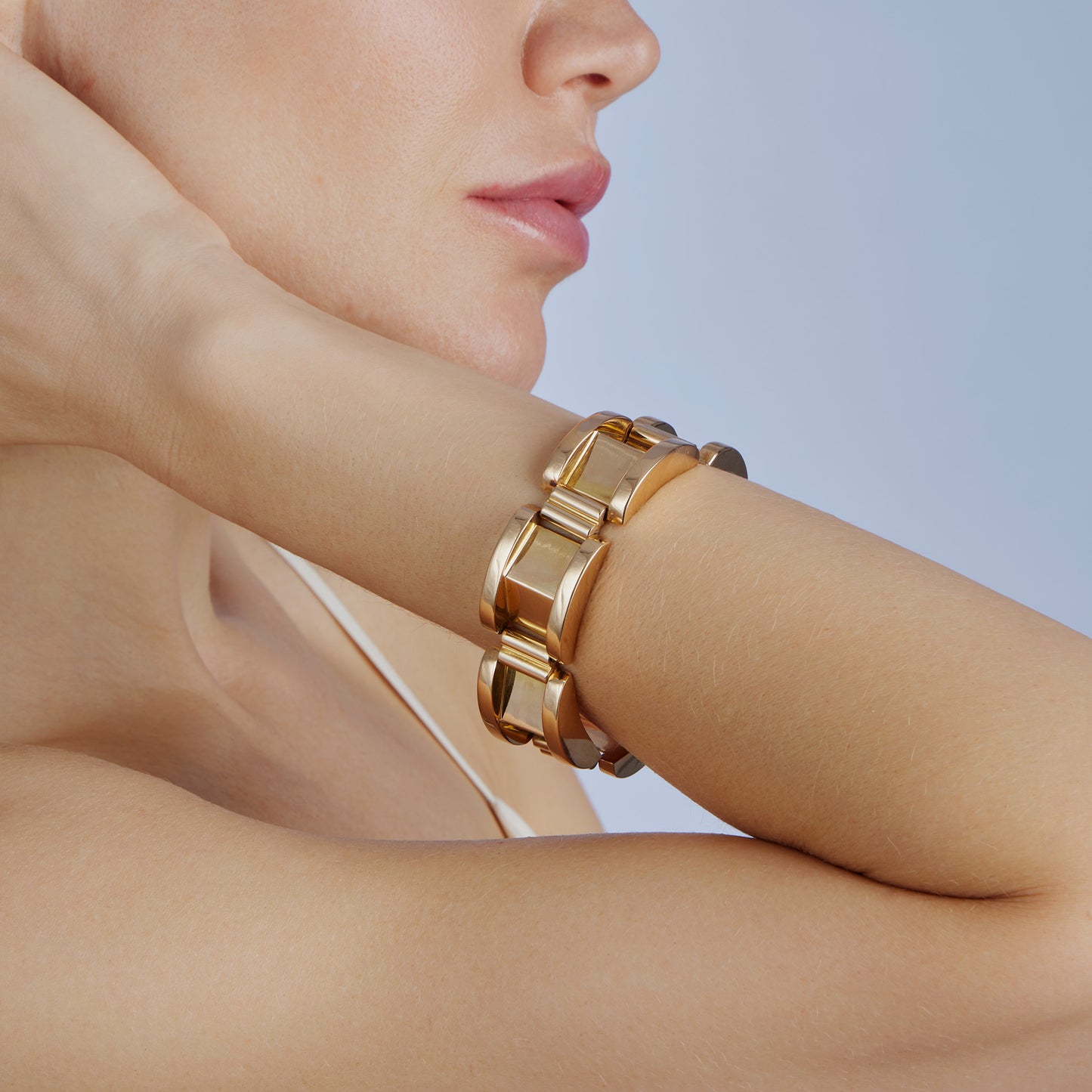
A favorite style of collectors for its spirit of casual glamour, the Rétro Moderne was a bold, visionary era in jewelry whose practitioners looked into the future and drew from the past simultaneously. With energy and originality, they created an unmistakable body of new work, drawing inspiration equally from cutting-edge industry and nature.
Rétro’s Roots in the 1930s
Prototypes of Rétro appeared in the early 1930s, when the Roaring Twenties fever had broken. Creators still looked to the future with excitement, while indulging in a touch of nostalgia for traditions that had been swept away. Artistic Parisian jewelers like Van Cleef & Arpels, with their finger on the pulse of the modern world, broke with the strict discipline of Art Deco with its cool platinum and diamond geometry and emphasis on the noble stones. Inspired by the industrial pipes used to feed combustion engines, the firm’s slinky, handmade “tubogas” bracelets took Paris by storm and helped long-neglected gold recapture its glamor on the arms of style makers like the Duchess of Windsor. Soft, flexible and voluminous, bracelets and necklaces of tubogas, often star-set with little gems, reminded women of everything they loved about gold. The modernist Jean Després, another jewelry thought leader, created gold bracelets and pendants featuring solid, massive forms and hammered surfaces, expressing the period tension between embrace of the industrial and nostalgia for the handmade. One of his important early designs unifies cylindrical and stepped machine parts with gentle ogee curves, the contrasting elements defined by distinct tones of rose, yellow and gray gold, the surfaces refined by the marks of the artist’s hammer.


Left: Tiffany & Co.18K Gold, Platinum and Diamond Bracelet, 1936, Right: Ethel DuPont, wearing Tiffany’s design in Fig. 4, photographed by Hoyningen-Huene, Harper’s Bazaar, July 1936, p. 60
Rétro Moderne in World War II and Beyond: From Tanks to Flowers
Stylish 18K gold Rétro bracelets became one of the period’s defining and most beloved jewels. As early as December 1937 Vogue editors had praised “massive gold bracelets- no woman ever has too many”. As war raged, tank tracks, which had inspired Louis Carter to create his hit wristwatch just after World War I, continued to energize design. Like Després’ work, these bracelets celebrated the nature of metal and the power of technology. Jewelers also sourced ideas from industrial designs like heavy chains and conveyor belts, highlighting their interplay of forms and voids. Jarretiere bracelets of flexible gold mesh with buckle closures were revived from the Victorian era, remaining in style from the late 1930s through the War and after.

Left: French Retro 18K Gold Tank Track Bracelet, c. 1940s, Middle: Italian Retro Tri-color Gold Bracelet, Vicenza, c. 1938-1944, Right: Janlys French Retro 18K Gold Tank Bracelet. ca. 1940s
Bold Italian work from historic Vicenza, like this polished tri-color gold bracelet of angular buckle motifs with oversize, angled facets, has a Futurist look. In another Parisian example, dissected circles and elongated cylinders are combined with peaked arches, creating unexpected sculptural and visual effects through contrast and reflection. A variation on the theme, designed as a smooth harmony of streamlined, stepped arches and hemi-cylinders, projects volume and offers pleasing weight and softness. Women responded with enthusiasm to the wartime aesthetic of strength, grace and resistance. Critical in the workforce, and freed from defined roles in the nuclear family, they reported feeling independent and happy during the war years, despite the hardships and dangers they faced. For women, these bracelets carried important meanings about self-determination, still relevant today.
Left: French 18K Gold Bracelet, Renard, Right: A wartime industrial-inspired gold bracelet by Cartier, New York, Vogue, October 1940, paired seamlessly with Leonardo’s model for Palais Romorantin
During the war years, sources of platinum, a rare, strategic metal, became targets of the warring powers. Platinum was banned for use in jewelry, reinforcing the ongoing shift in taste to yellow, rose and gray gold. In Vichy Paris, gold jewels of the Resistance included Cartier’s famous caged bird, as well as jaunty soldier, jeep and parachute brooches. Women, who directed design in almost every major house from Van Cleef & Arpels to Cartier to Herz Belperron and Boivin, redefined Retro rings in a monumental style, leading critics to term the new creations “mini-giants of volume.” Meanwhile, jewelers of Jewish heritage, such as Van Cleef & Arpels and their manufacturing partner John Rubel, relocated in New York, where they continued to create jewels of opulence and bravado. In support of the Resistance, like their counterparts Cartier and Boucheron in France, they referenced the colors of the French flag and hoped-for victory. Revived naturalism, represented in the International Flower style popularized by Duchess of Windsor and Hélène Arpels, embodied the two firms’ optimistic counterpoint to the hostilities.

Left: Map of Metropolitan/continental France under German occupation, Right: Caged Bird Brooch, Cartier Paris, c. 1944, French resistance jewel designed by artistic director Jeanne Toussaint
The Post-War 1940s: Cocktails and Celebration

Parisians line the Champs Élysées for a parade conducted by the French 2nd Armored Division on 26 August 1944.
Victory in Europe sparked joy that expressed itself vibrantly in couture and jewelry. Masculine fashions and military-industrial motifs retreated in favor of flora, fauna and femininity, often touched with playfulness and even surrealism. Geometry gave way to the softer visual language of oversize scrolls, bows, knots, fans, and blossoms. Tiffany & Co., which had manufactured precision parts for anti-aircraft guns during the War, now fully embraced the flower style. At once lavish and delicate, filling a cupped hand, a luxuriant Tiffany chrysanthemum centers icy-blue aquamarines off-set by concave gold petals creating depth and reflections, while diamonds sit like dewdrops above. 
Left: Tiffany & Co. Aquamarine and Diamond Flower Brooch, Middle: BA 18659 Retro Bicolor 18K Gold Bracelet, Right: Boucheron Paris 18K Gold “Palmettes” Bracelet, c. 1945.
Extravagant gold bracelets, now of rounded or naturalistic links, grew even wider, some unabashedly heavy. And a playful asymmetry can be found in the profusion of new ring styles shaped like boules, turbans, and bowknots. The best of these were daring and artistic, like this elegant high-relief Cartier cocktail ring which slyly plays with perception and perspective. And big gemstones – aquas, rubellites, topaz, citrines, amethysts, and yellow sapphires from India and Brazil – continued to grace sparkling hands. From its origins in the daring and artistic 1930s, through the rigor and austerity of war to the cocktail party era, glamorous and ever wearable Rétro Moderne flexed its originality and creative spark throughout.

Left: Barbara Stanwyck and Gary Copper at a Cocktail Party, 1946, Rigt top: Cartier Paris, 18K Gold and Diamond Retro Ring, c. 1945-1950, Right bottom: Reverse of Cartier Paris, 18K Gold and Diamond Rétro Ring, c. 1945-1950













